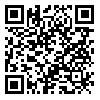Volume 3, Issue 1 (16 2004)
ijdld 2004, 3(1): 53-56 |
Back to browse issues page
Download citation:
BibTeX | RIS | EndNote | Medlars | ProCite | Reference Manager | RefWorks
Send citation to:



BibTeX | RIS | EndNote | Medlars | ProCite | Reference Manager | RefWorks
Send citation to:
Soveid M, Ghavanini M R, Shirdel E, Omrani G. CLINICAL AND ELECTRONEUROGRAPHIC EVALUATION OF NEUROPATHY AMONG DIABETIC PATIENTS IN SHIRAZ. ijdld 2004; 3 (1) :53-56
URL: http://ijdld.tums.ac.ir/article-1-456-en.html
URL: http://ijdld.tums.ac.ir/article-1-456-en.html
Abstract: (9453 Views)
Neuropathy is a common complication of diabetes mellitus. Meticulous neurological examination and electrodiagnosis are valuable tools in early diagnosis of neuropathy and prevention of its sequels.
Methods: A hundred and three randomly selected diabetic patients were recruited from the endocrine clinic. Mean age of patients was 52.6 ±14 years. 29.4% had type 1 and 70.6% had type 2 diabetes.
Medical history was taken from patients and neurological examination was done. Electroneurographic examination included nerve conduction velocity, action potential amplitude, distal latency and H reflex measurements.
Results: Neuropathy was found in 79.4% of patients. The prevalence of neuropathy had a direct relation with duration of the disease. The most common complaints were tingling and numbness of extremities (72%) and burning sensation of the feet (36%). The most common physical findings were abnormal ankle jerk (92%), and decreased vibration perception (76%) in feet. Abnormal H reflex
(92.5%) and decreased amplitude of action potentials (79%) were the most common electroneurographic findings. There was a strong correlation between clinical and electroneurographic findings.
Conclusion: Neuropathy was quite common in diabetic patients. Neurologic examination is, therefore, recommended to prevent unnecessary workups and prevent complications.
Methods: A hundred and three randomly selected diabetic patients were recruited from the endocrine clinic. Mean age of patients was 52.6 ±14 years. 29.4% had type 1 and 70.6% had type 2 diabetes.
Medical history was taken from patients and neurological examination was done. Electroneurographic examination included nerve conduction velocity, action potential amplitude, distal latency and H reflex measurements.
Results: Neuropathy was found in 79.4% of patients. The prevalence of neuropathy had a direct relation with duration of the disease. The most common complaints were tingling and numbness of extremities (72%) and burning sensation of the feet (36%). The most common physical findings were abnormal ankle jerk (92%), and decreased vibration perception (76%) in feet. Abnormal H reflex
(92.5%) and decreased amplitude of action potentials (79%) were the most common electroneurographic findings. There was a strong correlation between clinical and electroneurographic findings.
Conclusion: Neuropathy was quite common in diabetic patients. Neurologic examination is, therefore, recommended to prevent unnecessary workups and prevent complications.
| Rights and permissions | |
 |
This work is licensed under a Creative Commons Attribution-NonCommercial 4.0 International License. |





